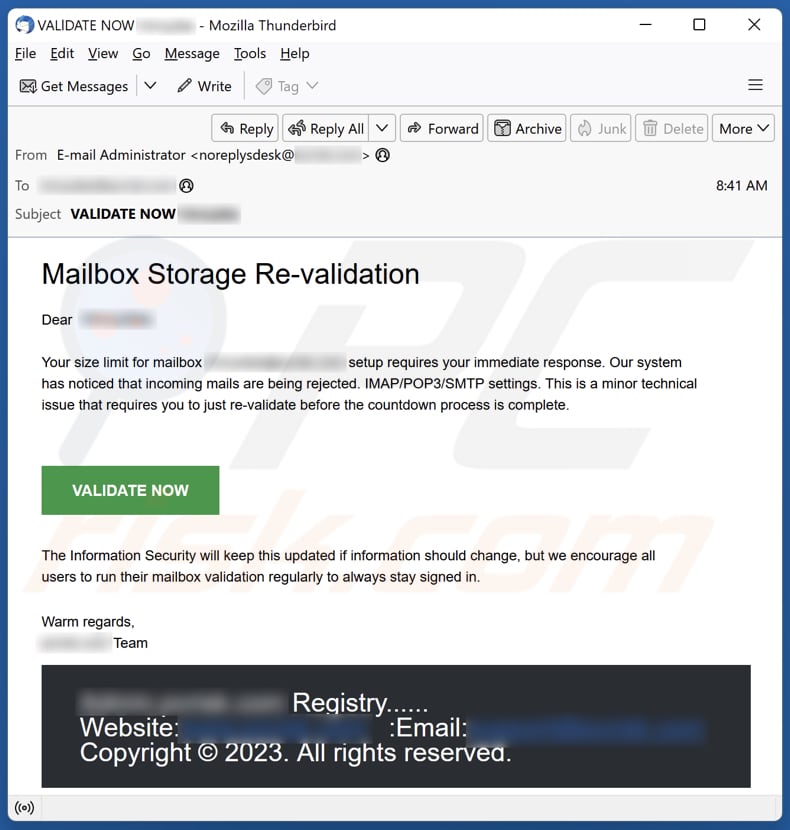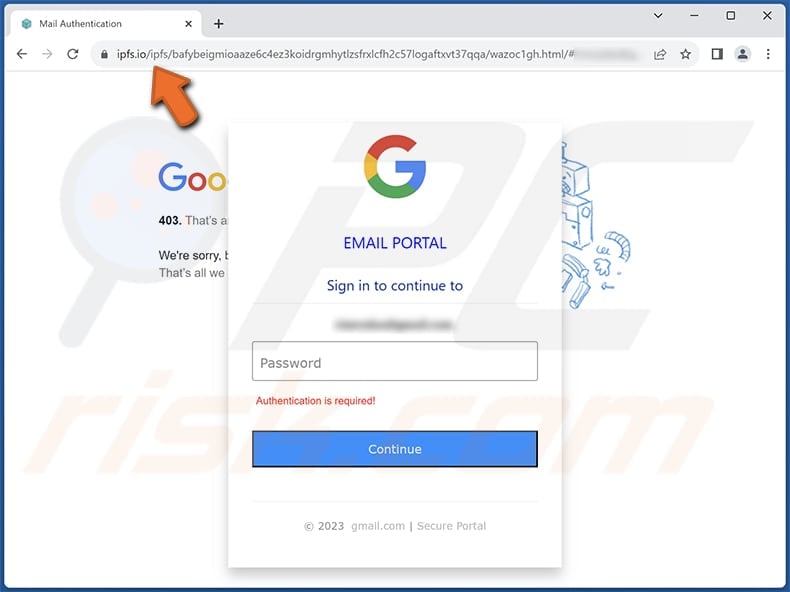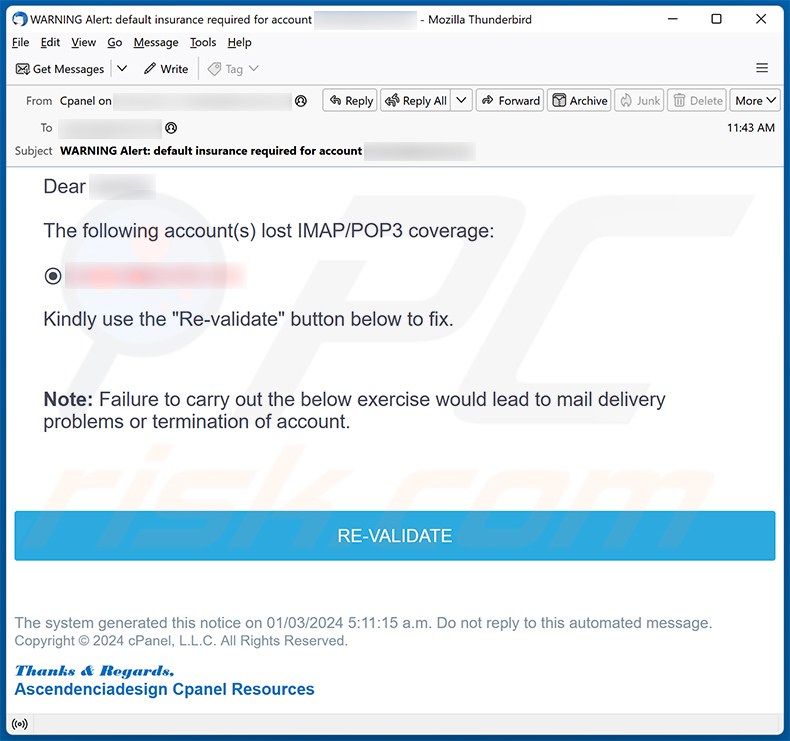How to identify scams like "Mailbox Storage Re-validation"
Phishing/ScamAlso Known As: Mailbox Storage Re-validation phishing email
Get free scan and check if your device is infected.
Remove it nowTo use full-featured product, you have to purchase a license for Combo Cleaner. Seven days free trial available. Combo Cleaner is owned and operated by RCS LT, the parent company of PCRisk.com.
What is "Mailbox Storage Re-validation"?
We have determined that this email is a fraudulent attempt by scammers to obtain personal information from recipients. Such emails are commonly known as phishing emails. In this instance, scammers pose as an email service provider to entice recipients into revealing their information on a phishing page.

More about the "Mailbox Storage Re-validation" scam email
The email uses a sense of urgency to prompt the recipient into taking immediate action. The subject line, "VALlDATE NOW", suggests an urgency to validate some aspect of the recipient's email account. The message claims that there is a mailbox storage re-validation requirement due to a purported issue with the size limit for the recipient's mailbox setup.
The email is designed to create a sense of concern by stating that the system has noticed incoming mail being rejected, citing IMAP/POP3/SMTP settings as the cause. It then urges the recipient to click the "VALlDATE NOW" button to resolve the alleged technical issue before a countdown process is complete.
Clicking on the provided button leads to a fake login webpage designed to mimic the appearance of the recipient's email service provider, tailored to match the recipient's email address. For instance, if the recipient uses Gmail, the deceptive page will closely resemble the official Gmail website.
The primary objective of this phishing page is to illicitly obtain email addresses and passwords (email account login credentials). Once scammers gain access to stolen email account login credentials, they exploit this information for various malicious activities.
One common practice involves unauthorized access to the victim's email account to harvest sensitive personal and financial information. Scammers may scour the compromised inbox for valuable data such as bank statements, login credentials for other accounts, or personal identification information.
Additionally, scammers often use compromised email accounts to launch phishing attacks on the victim's contacts. By sending deceptive emails from the compromised account, they attempt to trick friends, family, or colleagues into divulging their sensitive information or clicking on malicious links.
Moreover, scammers might use stolen email credentials to gain unauthorized access to other online platforms where the victim has accounts, exploiting the common practice of password reuse across multiple services.
| Name | Mailbox Storage Re-validation Scam |
| Threat Type | Phishing, Scam, Social Engineering, Fraud |
| Fake Claim | Incoming mail is being rejected |
| Disguise | Letter from an email service provider |
| Symptoms | Unauthorized online purchases, changed online account passwords, identity theft, illegal access of the computer. |
| Distribution methods | Deceptive emails, rogue online pop-up ads, search engine poisoning techniques, misspelled domains. |
| Damage | Loss of sensitive private information, monetary loss, identity theft. |
| Malware Removal (Windows) |
To eliminate possible malware infections, scan your computer with legitimate antivirus software. Our security researchers recommend using Combo Cleaner. Download Combo CleanerTo use full-featured product, you have to purchase a license for Combo Cleaner. 7 days free trial available. Combo Cleaner is owned and operated by RCS LT, the parent company of PCRisk.com. |
Similar scam emails in general
Phishing emails often create a sense of urgency or use fear tactics to prompt quick action. Scammers often use a familiar company name or imitate a trustworthy source, making it challenging to distinguish from genuine communication. As a rule, fraudsters include links or files to trick users into providing sensitive information on fake websites or other platforms.
It is important to know that attachments and links sent by malicious actors can contain malware. Some examples of phishing campaigns used to extract sensitive information are "DHL Shipping Invoice", "Maersk Line", and "ACH-ELECTRONIC FUNDS TRANSFER".
How do spam campaigns infect computers?
Cybercriminals often send emails with malicious attachments, such as executable files (.exe), JavaScript files (.js), or documents (.doc, .pdf, or others). When users download and open these attachments, the malware is executed, infecting the computer. Archive files and ISO files are also used in malware distribution.
Also, emails can contain links that lead to fraudulent websites hosting malware. Clicking on these links can trigger the download and installation of malicious software without the user's knowledge. It is crucial to note that not every file immediately infects computers upon opening.
For example, malicious MS Office documents can infect computers only when users enable macros (either for editing or content) within those documents.
How to avoid installation of malware?
Regularly update your operating system and software, including security solutions. Use reputable antivirus and (or) anti-malware software. Verify the legitimacy of emails before opening links or files (attachments). Download software and files from official pages or stores. Never download pirated software, cracking tools, or key generators.
Be cautious when visiting websites, especially those with suspicious or untrustworthy content. Stick to reputable websites and avoid clicking on pop-ups or ads on unfamiliar sites. If you have already opened malicious attachments, we recommend running a scan with Combo Cleaner Antivirus for Windows to automatically eliminate infiltrated malware.
Text presented in the "Mailbox Storage Re-validation" email letter:
Subject: VALlDATE NOW ********
Mailbox Storage Re-validation
Dear ********,Your size limit for mailbox ******** setup requires your immediate response. Our system has noticed that incoming mails are being rejected. IMAP/POP3/SMTP settings. This is a minor technical issue that requires you to just re-validate before the countdown process is complete.
VALlDATE NOW
The Information Security will keep this updated if information should change, but we encourage all users to run their mailbox validation regularly to always stay signed in.Warm regards,
******** Team
******** Registry......
Website:******** :Email:********
Copyright © 2023. All rights reserved.
Deceptive website utilized in this phishing campaign:

Another example of an email from "Mailbox Storage Re-validation" spam campaign:

Text presented within:
Subject: WARNING Alert: default insurance required for account ********
Dear ********
The following account(s) lost IMAP/POP3 coverage:
********
Kindly use the "Re-validate" button below to fix.
Note: Failure to carry out the below exercise would lead to mail delivery problems or termination of account.
RE-VALIDATE
The system generated this notice on 01/03/2024 5:11:15 a.m. Do not reply to this automated message. Copyright © 2024 cPanel, L.L.C. All Rights Reserved.
Thanks & Regards,
Ascendenciadesign Cpanel Resources
Instant automatic malware removal:
Manual threat removal might be a lengthy and complicated process that requires advanced IT skills. Combo Cleaner is a professional automatic malware removal tool that is recommended to get rid of malware. Download it by clicking the button below:
DOWNLOAD Combo CleanerBy downloading any software listed on this website you agree to our Privacy Policy and Terms of Use. To use full-featured product, you have to purchase a license for Combo Cleaner. 7 days free trial available. Combo Cleaner is owned and operated by RCS LT, the parent company of PCRisk.com.
Quick menu:
- What is Mailbox Storage Re-validation phishing email?
- Types of malicious emails.
- How to spot a malicious email?
- What to do if you fell for an email scam?
Types of malicious emails:
![]() Phishing Emails
Phishing Emails
Most commonly, cybercriminals use deceptive emails to trick Internet users into giving away their sensitive private information, for example, login information for various online services, email accounts, or online banking information.
Such attacks are called phishing. In a phishing attack, cybercriminals usually send an email message with some popular service logo (for example, Microsoft, DHL, Amazon, Netflix), create urgency (wrong shipping address, expired password, etc.), and place a link which they hope their potential victims will click on.
After clicking the link presented in such email message, victims are redirected to a fake website that looks identical or extremely similar to the original one. Victims are then asked to enter their password, credit card details, or some other information that gets stolen by cybercriminals.
![]() Emails with Malicious Attachments
Emails with Malicious Attachments
Another popular attack vector is email spam with malicious attachments that infect users' computers with malware. Malicious attachments usually carry trojans that are capable of stealing passwords, banking information, and other sensitive information.
In such attacks, cybercriminals' main goal is to trick their potential victims into opening an infected email attachment. To achieve this goal, email messages usually talk about recently received invoices, faxes, or voice messages.
If a potential victim falls for the lure and opens the attachment, their computers get infected, and cybercriminals can collect a lot of sensitive information.
While it's a more complicated method to steal personal information (spam filters and antivirus programs usually detect such attempts), if successful, cybercriminals can get a much wider array of data and can collect information for a long period of time.
![]() Sextortion Emails
Sextortion Emails
This is a type of phishing. In this case, users receive an email claiming that a cybercriminal could access the webcam of the potential victim and has a video recording of one's masturbation.
To get rid of the video, victims are asked to pay a ransom (usually using Bitcoin or another cryptocurrency). Nevertheless, all of these claims are false - users who receive such emails should ignore and delete them.
How to spot a malicious email?
While cyber criminals try to make their lure emails look trustworthy, here are some things that you should look for when trying to spot a phishing email:
- Check the sender's ("from") email address: Hover your mouse over the "from" address and check if it's legitimate. For example, if you received an email from Microsoft, be sure to check if the email address is @microsoft.com and not something suspicious like @m1crosoft.com, @microsfot.com, @account-security-noreply.com, etc.
- Check for generic greetings: If the greeting in the email is "Dear user", "Dear @youremail.com", "Dear valued customer", this should raise suspiciousness. Most commonly, companies call you by your name. Lack of this information could signal a phishing attempt.
- Check the links in the email: Hover your mouse over the link presented in the email, if the link that appears seems suspicious, don't click it. For example, if you received an email from Microsoft and the link in the email shows that it will go to firebasestorage.googleapis.com/v0... you shouldn't trust it. It's best not to click any links in the emails but to visit the company website that sent you the email in the first place.
- Don't blindly trust email attachments: Most commonly, legitimate companies will ask you to log in to their website and to view any documents there; if you received an email with an attachment, it's a good idea to scan it with an antivirus application. Infected email attachments are a common attack vector used by cybercriminals.
To minimise the risk of opening phishing and malicious emails we recommend using Combo Cleaner Antivirus for Windows.
Example of a spam email:

What to do if you fell for an email scam?
- If you clicked on a link in a phishing email and entered your password - be sure to change your password as soon as possible. Usually, cybercriminals collect stolen credentials and then sell them to other groups that use them for malicious purposes. If you change your password in a timely manner, there's a chance that criminals won't have enough time to do any damage.
- If you entered your credit card information - contact your bank as soon as possible and explain the situation. There's a good chance that you will need to cancel your compromised credit card and get a new one.
- If you see any signs of identity theft - you should immediately contact the Federal Trade Commission. This institution will collect information about your situation and create a personal recovery plan.
- If you opened a malicious attachment - your computer is probably infected, you should scan it with a reputable antivirus application. For this purpose, we recommend using Combo Cleaner Antivirus for Windows.
- Help other Internet users - report phishing emails to Anti-Phishing Working Group, FBI’s Internet Crime Complaint Center, National Fraud Information Center and U.S. Department of Justice.
Frequently Asked Questions (FAQ)
Why did I receive this email?
Scammers send out identical letters to a large number of people, hoping that at least one recipient will fall victim to their scheme. These unsolicited emails lack any form of personalization.
I have provided my personal information when tricked by this email, what should I do?
In the event that you have been ensnared by a phishing scam and revealed your email address and password, take immediate action. Change your password promptly, and if available, activate two-factor authentication for added security. It is crucial to promptly notify your email service provider about the incident. Additionally, it is advisable to update passwords for other accounts sharing the same login credentials to prevent unauthorized access.
I have downloaded and opened a malicious file attached to an email, is my computer infected?
If the file in question was an executable, there is a high probability of infection. On the other hand, if it happened to be a document in formats like .pdf or .doc, there is a chance you avoided the infection, as simply opening such documents may not be sufficient for malware to compromise the system in certain instances.
I have read the email but did not open the attachment, is my computer infected?
If you have read an email but avoided opening the attachment, your computer is not infected. Malware typically requires execution, which means opening or running an infected file.
Will Combo Cleaner remove malware infections that were present in email attachment?
Combo Cleaner possesses the ability to identify and remove nearly all malware infections. It is essential to recognize that advanced malware tends to hide deep within the system. Consequently, performing a thorough system scan is essential for detection and removal.
Share:

Tomas Meskauskas
Expert security researcher, professional malware analyst
I am passionate about computer security and technology. I have an experience of over 10 years working in various companies related to computer technical issue solving and Internet security. I have been working as an author and editor for pcrisk.com since 2010. Follow me on Twitter and LinkedIn to stay informed about the latest online security threats.
PCrisk security portal is brought by a company RCS LT.
Joined forces of security researchers help educate computer users about the latest online security threats. More information about the company RCS LT.
Our malware removal guides are free. However, if you want to support us you can send us a donation.
DonatePCrisk security portal is brought by a company RCS LT.
Joined forces of security researchers help educate computer users about the latest online security threats. More information about the company RCS LT.
Our malware removal guides are free. However, if you want to support us you can send us a donation.
Donate
▼ Show Discussion